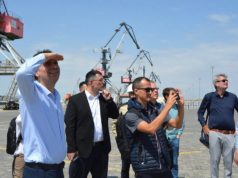Trend: Sidelined for long due to international sanctions, Iran now is gradually turning back to the family of the most essential tourist destinations. Persepolis alone (the capital of the ancient Achaemenid Empire, 550-330 BC) is worth of visiting the country.
Obviously, after relief of sanctions President Rouhani zeroed in on economic development. If driven forward, tourism industry can be an important part in generating the country’s economic growth. In addition to demonstrating openness to the world, it will bring new jobs and considerable profits.
In this connection the idea of Caspian cruise tourism, as a novelty never experienced by Caspian littoral states, looks attractive.
According to Travel & Tourism Competitive Report 2017, the number of people on the move is unprecedented, with international tourist arrivals increasing from just 25 million in the 1950s to 1.2 billion in 2016.
The report recorded an increased number of foreign tourists. In 2016, 5.24 million tourists visited Iran, but Iranian officials indicate to six million.
According to Iranian Culture and Heritage Organization’s official statistics, over the first five months of the current Iranian fiscal year, 2.159 million tourists arrived in Iran.
The top five nations are Iraq, Azerbaijan, Afghanistan, Turkey and Pakistan. Then the ranking is as follows: Turkmenistan, Bahrain, Kuwait, India, China, Germany, Lebanon, France, Italy, Oman and Georgia.
But Iranians themselves are also keen to travel abroad. According to the same statistics (over the last fiscal year, ending March 20, 2017), 9.196 million Iranian tourists visited foreign countries, including (top 5): Turkey, Iraq, the UAE, Azerbaijan, and Armenia. Then we have Georgia, Germany and Saudi Arabia.
It is worthy to note that Iraq and Saudi Arabia have been purely religious destinations for Iranians, i.e. Iraqi Karbala and Najaf as sacred shrines for Shias and the Saudis’ Mekka as Hajj, the annual Islamic pilgrimage to Mecca.
Turkey is the most popular tourist destination for Iranians. The latest statistics by the Culture and Tourism Ministry of Turkey indicates that the number of Iranian tourists in the country has exceeded 1 million over the first half of the current year. This is mostly explained by the cheapest average receipts per arrival in Turkey.
As to Azerbaijan, it is involved mainly in medical tourism to the neighboring country.
The number of tourists from the EU and the US visiting Iran is also increasing, Abdolreza Mohajerinejad, an official at Iran’s Cultural Heritage, Handicrafts and Tourism Organization, said. Without unveiling the exact number of Western tourists, who visited Iran, Mohajerinejad noted that during the 15-month period from March 2016 to June 2017, their number rose by 56.6 percent, year-on-year.
According to data from World Travel & Tourism Council (WTTC), the direct contribution of Travel & Tourism to Iran’s GDP was $11.9 billion, 2.9 percent of total GDP in 2016 and is forecast to rise by 7.5 percent in 2017. In 2016, Travel & Tourism directly supported almost 560,000 jobs (2.2 percent of total employment). This is expected to rise by 4.9 percent in 2017.
However, international openness, tourist service infrastructure, mobile network coverage are among the weakest indicators of T&T performance.
Now Iranian private sector, in cooperation with the state railroads, is actively making use of “Orient Express” style “luxury trains” meant for entertainment purposes and driving foreign tourists all across the country. At the same time tourists, of which Europeans constitute a majority, have the opportunity to observe historical, archaeological and cultural heritage places Iran is rich in.
Caspian Sea still remains virgin as an attractive tourist destination. Iranian business with support of state bodies can discover it for international tourist community similarly to “luxury trains” experience. Caspian cruise on a middle size luxury ship calling at main ports of the Caspian littoral states could become a new segment in Iran’s tourism industry and a popular type of tourism for Iranians themselves. Iranians, especially young generation, can take advantage of it by spending their vacations in all-inclusive mode, and visiting countries they have never been to before.
The 2016 annual report issued by Cruise Lines International Association (CLIA) shows that cruise tourism industry is rapidly growing. The economic impact for the industry in 2015 made $117 billion. More than 24 million people enjoyed a cruise in 2016 (compare it to 3.7 million in 1990). $38 billion were earned in total wages for the entire industry, which currently provides more than 950,000 jobs.
Finally, the idea could make all Caspian states closer to each other by reinforcing cooperation around all cruise-related activities and conditions, such as technical parameters of harbors and quays, availability of passenger terminals and associated infrastructure, customs and security issues, arrangement of guided sightseeing tours and city shopping tours, etc.
This all could result in a good economic impact on the whole region.
© Content from this site must be hyperlinked when used






